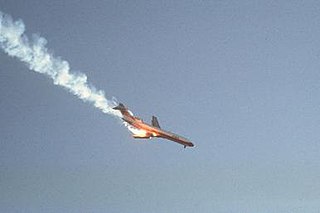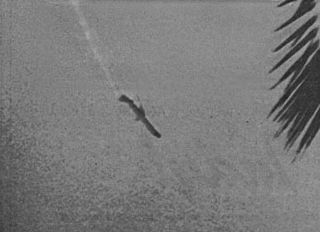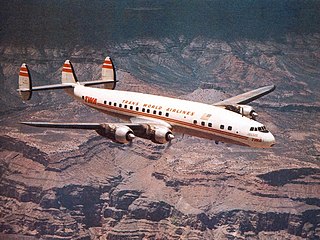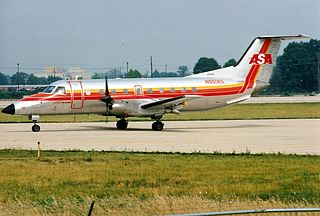SkyWest Airlines is an American regional airline headquartered in St. George, Utah, United States. SkyWest is paid to staff, operate and maintain aircraft used on flights that are scheduled, marketed and sold by a partner mainline airline. The airline is contracted by Alaska Airlines, American Airlines, Delta Air Lines, and United Airlines. In all, it is the largest regional airline in North America when measured by fleet size, number of passengers carried, and number of destinations served.

Pacific Southwest Airlines (PSA) Flight 182 was a Boeing 727-214 commercial airliner, registration N533PS, that collided with a private Cessna 172 light aircraft, registration N7711G, over San Diego, California, at 9:01 am on Monday, September 25, 1978. It was Pacific Southwest Airlines' first fatal accident, and the deadliest air disaster in California history.

Aeroméxico Flight 498 was a scheduled commercial flight from Mexico City, Mexico, to Los Angeles, California, United States, with several intermediate stops. On Sunday, August 31, 1986, the McDonnell Douglas DC-9 operating the flight was clipped in the tail section by N4891F, a Piper PA-28-181 Cherokee owned by the Kramer family, and crashed into the Los Angeles suburb of Cerritos, killing all 67 on both aircraft and an additional 15 on the ground. Eight on the ground also sustained minor injuries from the midday crash. Blame was allocated equally between the U.S. Federal Aviation Administration (FAA) and the pilot of the Cherokee. No fault was found with the DC-9 or the actions of its crew.

On 12 November 1996, Saudi Arabian Airlines Flight 763, a Boeing 747 en route from Delhi, India, to Dhahran, Saudi Arabia, and Kazakhstan Airlines Flight 1907, an Ilyushin Il-76 en route from Chimkent, Kazakhstan, to Delhi, collided over the village of Charkhi Dadri, around 100 km west of Delhi. The crash killed all 349 people on board both planes, making it the world's deadliest mid-air collision and the deadliest aviation accident to occur in India.

On the evening of February 1, 1991, USAir Flight 1493, a Boeing 737-300, collided with SkyWest Flight 5569, a Fairchild Swearingen Metroliner turboprop aircraft, upon landing at Los Angeles International Airport (LAX). Though air traffic was not heavy at LAX, as Flight 1493 was on final approach, the local controller was distracted by a series of abnormalities, including a misplaced flight progress strip and an aircraft that had inadvertently switched off the tower frequency. The SkyWest flight was told to taxi into takeoff position, while the USAir flight was landing on the same runway.

Trans World Airlines (TWA) Flight 553 was a McDonnell Douglas DC-9-15 jet airliner, registration N1063T, operated by Trans World Airlines in American airspace en route from Pittsburgh to Dayton. While descending toward Dayton about 29 miles from the airport, the flight collided in midair with a Beechcraft Baron near Urbana, Ohio, on March 9, 1967. All 26 people, 25 on the DC-9 and the pilot of the Beechcraft perished.

Allegheny Airlines Flight 853 was a regularly scheduled Allegheny Airlines flight from Boston, Massachusetts, to St. Louis, Missouri, with stops in Baltimore, Maryland, Cincinnati, Ohio, and Indianapolis, Indiana. On September 9, 1969, the aircraft serving the flight, a McDonnell Douglas DC-9, collided in mid-air with a Piper PA-28 light aircraft near Fairland, Indiana. The DC-9 was carrying 78 passengers and 4 crew members, and the Piper was leased to a student pilot on a solo cross-country flight. All 83 occupants of both aircraft were killed in the accident and both aircraft were destroyed.

Piedmont Airlines Flight 22, a Piedmont Airlines Boeing 727-22 and a twin-engined Cessna 310 collided on July 19, 1967, over Hendersonville, North Carolina, United States. Both aircraft were destroyed and all passengers and crew were killed, including John T. McNaughton, an advisor to Robert McNamara. The aircraft were both operating under instrument flight rules and in radio contact with the Asheville control tower, though on different frequencies. The accident investigation carried out in the aftermath of the crash was the first major investigation ever conducted by the newly created National Transportation Safety Board. A review of the investigation, conducted 39 years after the crash, upheld the original findings that had placed primary responsibility on the Cessna pilot.

Comair Flight 5191, marketed as Delta Connection Flight 5191, was a scheduled United States domestic passenger flight from Lexington, Kentucky, to Atlanta, Georgia, operated on behalf of Delta Connection by Comair. On the morning of August 27, 2006, at around 06:07 EDT, the Bombardier Canadair Regional Jet 100ER crashed while attempting to take off from Blue Grass Airport in Fayette County, Kentucky, 4 miles (6.4 km) west of the central business district of the city of Lexington.

Gol Transportes Aéreos Flight 1907 was a scheduled flight of Gol Transportes Aéreos from Manaus, Brazil, to Brasília and Rio de Janeiro. On 29 September 2006, the Boeing 737-8EH serving the flight collided in midair with an Embraer Legacy 600 business jet over the Brazilian state of Mato Grosso. The upturned wingtip of the Embraer sliced off about half of the 737's left wing. The 737 broke up in midair and crashed into an area of dense jungle, killing all 154 passengers and crew on board. Despite sustaining serious damage to its left wing and tail, the Embraer Legacy jet landed with its seven occupants uninjured.

Hughes Airwest Flight 706 was a regularly scheduled flight operated by American domestic airline Hughes Airwest, from Los Angeles, California, to Seattle, Washington, with several intermediate stops. On Sunday, June 6, 1971, the McDonnell Douglas DC-9 serving the flight collided in midair with a McDonnell Douglas F-4 Phantom II of the United States Marine Corps over Southern California, killing all passengers and crew on the DC-9.

A runway incursion is an aviation incident involving improper positioning of vehicles or people on any airport runway or its protected area. When an incursion involves an active runway being used by arriving or departing aircraft, the potential for a collision hazard or Instrument Landing System (ILS) interference can exist. At present, various runway safety technologies and processes are commonly employed to reduce the risk and potential consequences of such an event.

The 2007 San Francisco International Airport runway incursion occurred around 1:36 p.m. PDT on May 26, 2007 when SkyWest Airlines Flight 5741, an Embraer EMB 120 Brasilia turboprop aircraft, nearly collided with Republic Airlines Flight 4912, an Embraer 170 Regional Jet, at the intersection of Runways 1L and 28R at San Francisco International Airport (SFO) in South San Francisco, California.

The Grand Canyon mid-air collision occurred in the western United States on Saturday, June 30, 1956, when a United Airlines Douglas DC-7 struck a Trans World Airlines Lockheed L-1049 Super Constellation over Grand Canyon National Park, Arizona. All 128 on board both flights perished, making it the first commercial airline incident to exceed one hundred fatalities. The flights had departed Los Angeles International Airport minutes apart for Chicago and Kansas City, respectively.

On August 8, 2009, at 11:53 a.m. (15:53 UTC), nine people died when a tour helicopter and a small private airplane collided over the Hudson River near Frank Sinatra Park in Hoboken, New Jersey. The aircraft were in an area known as the "Hudson River VFR Corridor", which extends from the surface of the river to altitudes of 800 to 1,500 feet at various locations along the Hudson River in the immediate area of New York City. Within this corridor, aircraft operate under visual flight rules (VFR), under which the responsibility to see and avoid other air traffic rests with the individual pilots rather than with the air traffic controller.

United Express Flight 5925, operated by Great Lakes Airlines with a Beechcraft 1900 twin turboprop, was a regularly scheduled flight from Chicago O'Hare International Airport to Quincy, Illinois, with an intermediate stop in Burlington, Iowa.

On April 9, 1990, Atlantic Southeast Airlines Flight 2254, a scheduled passenger flight from Muscle Shoals, Alabama, to Gadsden, Alabama, to Atlanta, Georgia, was involved in a mid-air collision with a Cessna 172 over Gadsden. The collision resulted in the death of the pilot and passenger of the Cessna 172.

Northwest Airlines Flight 188 was a regularly scheduled flight from San Diego, California, to Minneapolis, Minnesota, on October 21, 2009, which landed over one hour late in Minneapolis after overshooting its destination by more than 150 miles (240 km) because of pilot error. As a result of the incident, the Federal Aviation Administration (FAA) revoked the pilot certificates of the involved pilots and the National Transportation Safety Board (NTSB) issued recommendations to air traffic control procedures and changes in the rules for cockpit crew and air traffic controllers. The incident also caused American lawmakers to move to prevent pilots on U.S. airliners from using electronic devices while taxiing or flying. Changes to flight deck automation have also been suggested, and prototype designs that could mitigate errors leading to similar incidents have been described.

On July 7, 2015, an F-16 fighter jet operated by the United States Air Force collided in-flight with a private Cessna 150 single-engine light aircraft over Moncks Corner, South Carolina, United States. Both occupants of the Cessna were killed; the pilot of the F-16 ejected safely.

On July 7, 2017, an Airbus A320-211 operating as Air Canada Flight 759 was nearly involved in an accident at San Francisco International Airport in San Mateo County, California, United States. The flight, which originated at Toronto Pearson International Airport, had been cleared by air traffic control to land on San Francisco's runway 28R and was on final approach to land on that runway; however, instead of lining up with the runway, the aircraft had lined up with a parallel taxiway on which four fully loaded and fueled passenger airplanes were stopped awaiting takeoff clearance. The flight crew initiated a go-around prior to landing, after which it landed without further incident. The aircraft on the taxiway departed for their intended destinations without further incident. The subsequent investigation by the National Transportation Safety Board (NTSB) determined that the Air Canada airplane descended to 59 feet (18 m) above the ground before it began its climb, and that it missed colliding with one of the aircraft on the taxiway by 14 feet (4.3 m).




















